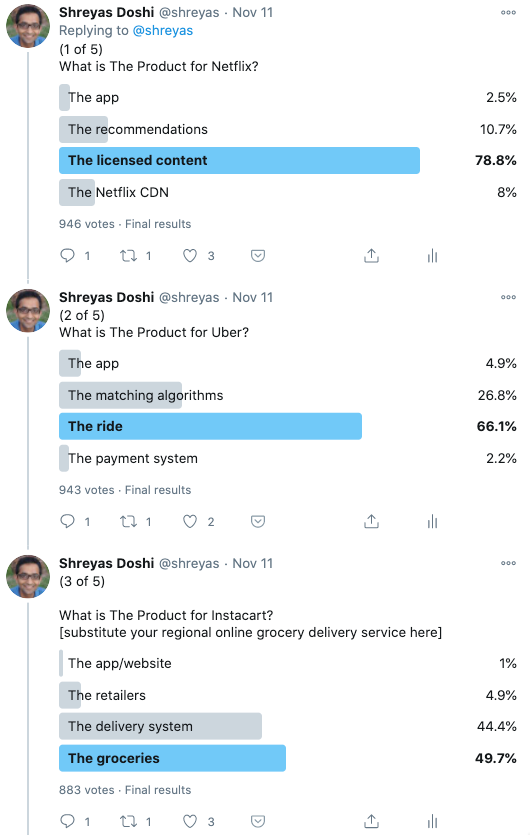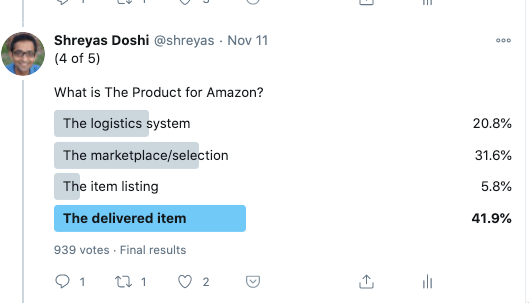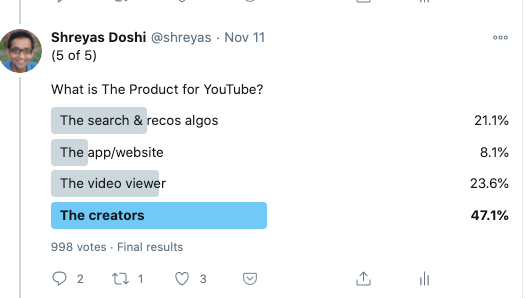
Sometimes there's a difference between the product & The Product.
"the lowercase-p product" is the thing you’ve been assigned to directly work on.
But that’s not necessarily "The uppercase-p Product".
The Product is The Main Thing that makes or breaks the user value prop.
👇🏾
"the lowercase-p product" is the thing you’ve been assigned to directly work on.
But that’s not necessarily "The uppercase-p Product".
The Product is The Main Thing that makes or breaks the user value prop.
👇🏾
Often:
product == Product
For example:
If you manage Google Calendar, the pixels on the screen (the product) are also what the user views as The Main Thing (The Product).
product == Product
For example:
If you manage Google Calendar, the pixels on the screen (the product) are also what the user views as The Main Thing (The Product).
Sometimes:
product ≠ Product
For example:
If you manage the Netflix app, you are managing the product, but that isn't The Product
The Product is all the content that Netflix has licensed.
the product you manage is merely a delivery mechanism for the real Product for the user.
product ≠ Product
For example:
If you manage the Netflix app, you are managing the product, but that isn't The Product
The Product is all the content that Netflix has licensed.
the product you manage is merely a delivery mechanism for the real Product for the user.
Why does it matter?
Too often, in the throes of the complexity of execution, we get lost in the details of the pixels we've been asked to manage
So we need to remember this:
Instead of optimizing for the product, we need to optimize for The Product, when the two are in conflict.
Too often, in the throes of the complexity of execution, we get lost in the details of the pixels we've been asked to manage
So we need to remember this:
Instead of optimizing for the product, we need to optimize for The Product, when the two are in conflict.
Quiz👇🏾
(questions sorted by difficulty, easier ones first)
(questions sorted by difficulty, easier ones first)
(1 of 5)
What is The Product for Netflix?
What is The Product for Netflix?
(2 of 5)
What is The Product for Uber?
What is The Product for Uber?
(3 of 5)
What is The Product for Instacart?
[substitute your regional online grocery delivery service here]
What is The Product for Instacart?
[substitute your regional online grocery delivery service here]
(4 of 5)
What is The Product for Amazon?
What is The Product for Amazon?
(5 of 5)
What is The Product for YouTube?
What is The Product for YouTube?
Thanks for playing, and remember:
-the product you manage is not always The Product that users care about most
-like Amazon, you can at times intentionally modify what the user views as The Product, by differentiating on certain things & commoditizing other things. Strategy FTW
-the product you manage is not always The Product that users care about most
-like Amazon, you can at times intentionally modify what the user views as The Product, by differentiating on certain things & commoditizing other things. Strategy FTW
Back to the top of this thread:
https://twitter.com/shreyas/status/1326795347105116161
My answers for the quiz:
The Product for
Netflix = the Content
Uber = the Ride
Instacart = the Groceries
Most folks got these right.
The Product for
Netflix = the Content
Uber = the Ride
Instacart = the Groceries
Most folks got these right.

The Product for Amazon, sure, the Delivered Item. But with the relatively consistent expectations across major retailers that items are rarely delivered damaged & they are very rarely scammy, the Marketplace/Selection & the Logistics are increasingly The Product for Amazon. 

YouTube is the most interesting one.
YouTube is a highly search & discovery driven experience, so their Search & Recommendation Algorithms (and associated UI) would get my vote for The Product. Next after that would be the Creators. Creator fragmentation is good for YouTube.
YouTube is a highly search & discovery driven experience, so their Search & Recommendation Algorithms (and associated UI) would get my vote for The Product. Next after that would be the Creators. Creator fragmentation is good for YouTube.

Hope you enjoyed this thread & the quiz.
• • •
Missing some Tweet in this thread? You can try to
force a refresh



